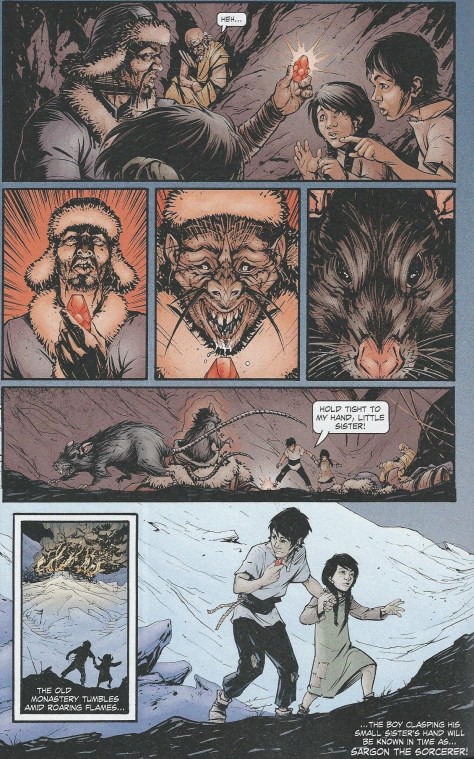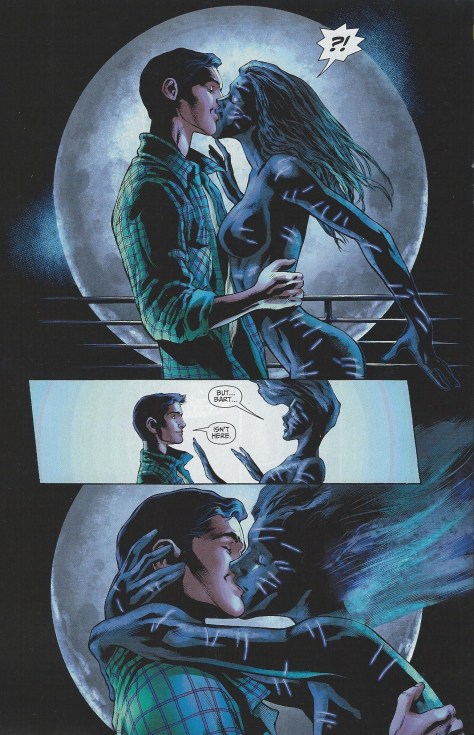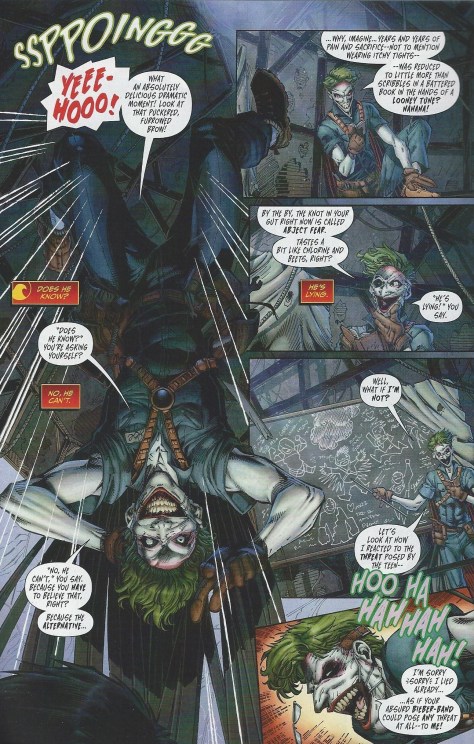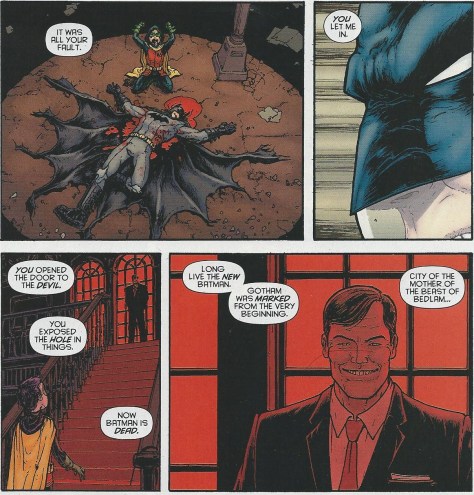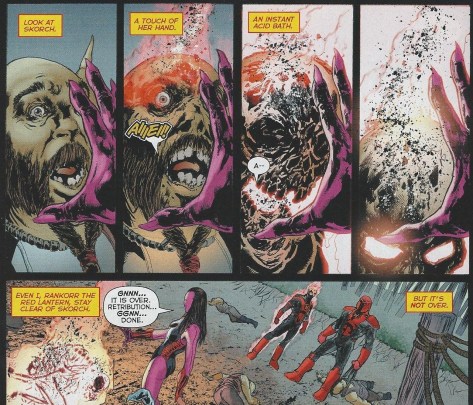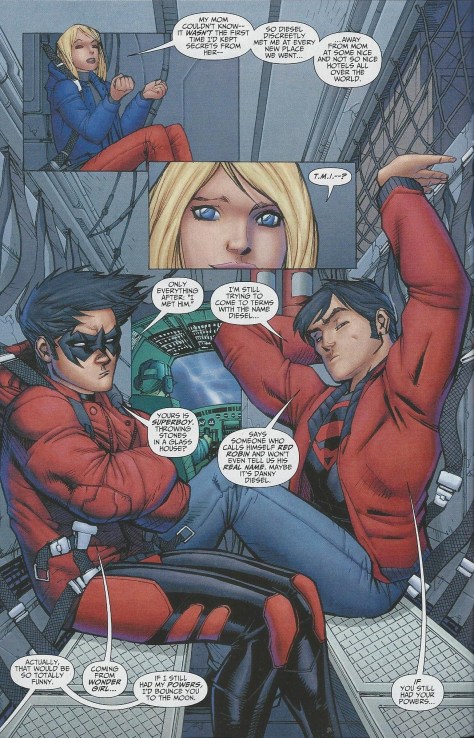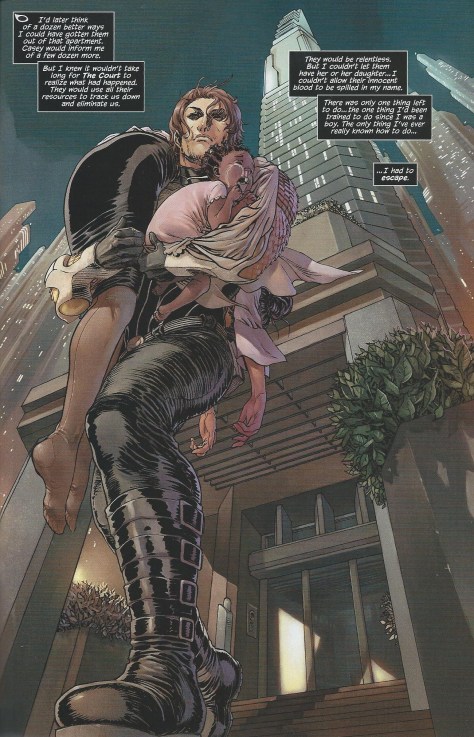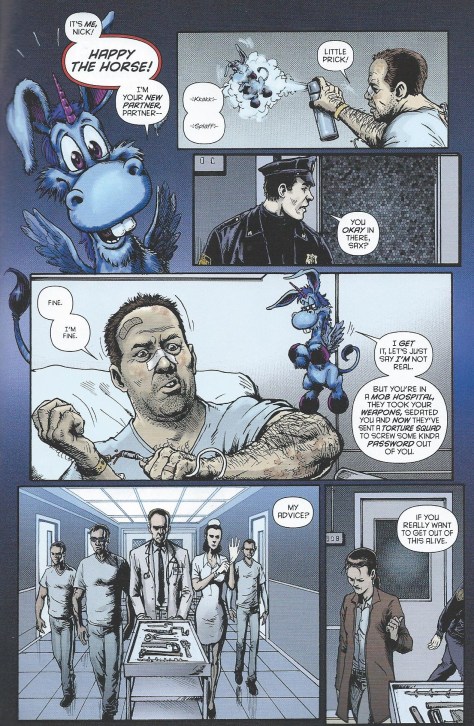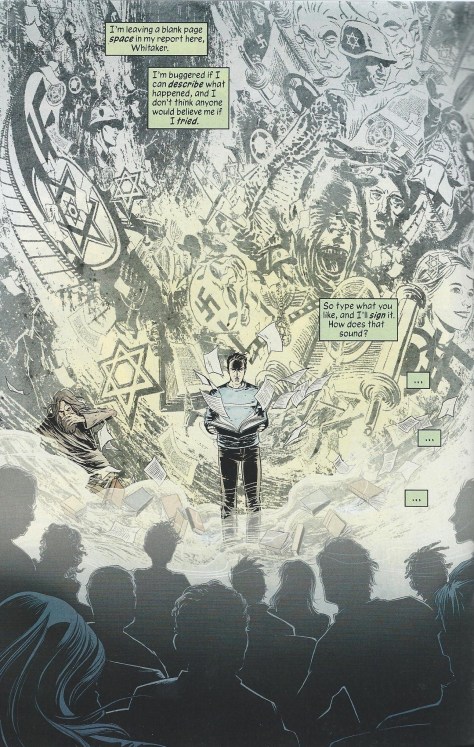- Batman Inc #10 enters into its endgame. After this issue, Grant Morrison only has three more issues before reaching what hopefully will be the meteoric conclusion of an eight year, continuous run on the character. There is a lot of pressure, but it seems like he’s had the end in sight the whole time and doubtless has been building toward and accentuating the events leading to his final goal. So far, Talia Al-Ghul has Gotham as well as the world in her grasp with her criminal organization and their meta-bomb ring that will encircle the world in destruction. Batman and his allies have once again been outlawed in Gotham, but when you take away everything from someone you also remove many of their inhibitions, and considering what Batman is capable of, that is a very dangerous prospect. Perhaps the greatest moment in the issue comes when Talia goes to visit her father, Ra’s Al-Ghul, in his Alpine prison to gloat about her genius in doing what he never could: conquering the Bat. Truly, to the casual observer Talia is in a very advantageous position. Ra’s is aptly playing chess as this conversation proceeds and while applauding his daughter’s plan, he cryptically hints that she has overlooked a key factor. Though haughty and convinced of her plan’s perfection, Ra’s doesn’t reveal what he means. The chink in her perfect plot begins to show, and with three more issues it is probable that we will watch as the crack begins to run until the plan it mars shatters entirely. With Morrison at the helm I am a’quiver with anticipation. One also has to acknowledge the incredible artwork of Chris Burnham that brings this series to beauteous life.
- Red Lanterns #19 is the final stepping stone to Green Lantern #20 that promises to end the Green Lantern Universe as we know it. Three long weeks from now we will be seeing the end of Geoff Johns’ run on the title he literally brought back from the dead eight years ago and the putting down of the last and greatest of his villains, Volthoom the First Lantern. In this issue bridging Red Lanterns #1-18 to the conclusion of Green Lantern Atrocitus has hit perhaps the greatest existential dilemma. His entire life thus far since the destruction of his space sector and the murder of his family has been lived with one singular purpose: vengeance. He has lived specifically to kill those who wronged him and the hundreds of billions of innocents throughout Space Sector 666. His rage was so great that he founded a lantern corps to spread his doctrine of revenge to the four corners of the universe. Every step of the way he has been robbed of his ultimate aims, i.e. the death of Sinestro, who escaped and thrived as both a Green and Yellow Lantern, and Krona who fell at the hands of Hal Jordan. When fighting Volthoom, he was given the choice to save his sector and become a tyrant, or let his sector be destroyed by Krona and the Manhunters and become that which he currently is. Seeing his death in the first alternative at the hands of his son, as well as his murder of his beloved wife, he chooses to let his world and family be destroyed. Afterwards, he finds nothing but self-recrimination and orders his faithful Red Lanterns to kill him for his crime of genocide by cowardice. The Red Lanterns find themselves in a conundrum as Atrocitus is the one who saved them and gave them the power to avenge the great wrongs done to them in their previous lives. At the same time they also swore obedience to him and he is telling them to kill him for the honor of their corps. Something of a Catch-22. They go through with it, but in the moment of their convergence on him to take his life, something interesting happens. Their attacks do not kill him, but rather give him a universal awareness of their combined suffering, rejuvenating in him the need and savory of vengeance he had begun to lose touch with in the first issue. Full circle, he is now once again the Regent of Rage and attempts to get vengeance on the one remaining enemy of his that remains to be conquered: the Guardians of the Universe. That said, the full might of the Red Lantern Corps are headed to Oa. Peter Milligan is a maestro, writing this series philosophically to a tee. Joining him on art is Will Conrad, whose art is light-years above that of regular series artist Miguel Sepulveda. The next issue will be both men’s swansong on the title following the aftermath of Green Lantern #20. I can barely wait.
- Flash #19 features Barry Allen in Iron Heights prison, playing a balancing act. One one side he’s attempting to keep the Trickster’s acolytes, the Outlanders, from storming the city and the prison to release their leader. On the other hand, he’s also trying to prove Trickster’s innocence on the murder rap he was sent up on. If that wasn’t enough, his powers are mysteriously sucked out of him in a very unlikely crossover with the series Dial H. Though linked to a very weak series, this mishap provides a golden opportunity for Barry Allen, not the Flash, to shine. Somehow, Barry pulls off a miracle, but in doing so unravels some mysteries about the Speed Force and his connection to it, as well as others’. The most intriguing of which comes at the end of the book with he entrance of the Reverse Flash. Brian Buccellato writes this issue exquisitely with the help of Marcio Takara on art. Francis Manapul returns as artist and cowriter on the last two pages introducing Reverse Flash. The future of the Flash shines bright in the hands of two writer/artists who get it. The Flash is a title to get for the foreseeable future as a result.
- Superman #19 is literally comic book legend in the making. The main plot follows Clark being invited to a housewarming party for Lois Lane and Jonathan Carroll. This may seem awkward for poor old Clark, but for the fact that while he is tying up a loose end in his super-heroics as Superman his girlfriend, Diana Prince, arrives before him and literally stuns everyone there: Lois, Perry, and especially Jimmy. Clark does eventually get to the party and when he gets there he notices discernible peculiarities in the words and actions of those present. Superman may have super-speed, super-strength, super-vision, heat-vision, freezing breath, etc, but Clark Kent has the hyper acute intuition and attention to detail of a trained journalist. Tying it to the same phenomenon he witnessed last issue at the midtown club where dozens of young women attempted to mindlessly plummet to their doom. All of this ties enigmatically to Hector Hammond, kept in a comatose state at S.T.A.R. Labs, and the New God, Orion, dispatched to Earth in order to save the universe from an up and coming threat originating on Earth. Writer Scott Lobdell GETS Superman not unlike the team of Buccellato and Manapul get the Flash. The core story of this issue as I’ve related it is what gives the series structure, but the strength of Lobdell’s writing is the strange and fantastic events that surround the main story, accentuating the world in which Superman exists. Case in point, Clark is late to the house warming party. He’s late because of an invasion of radiant Roman-eque legions of beings called Sunturnians from a placed called Neo Sol. Superman is brought before their “Solaratrix”, Allysun, and made to kneel before her. The look of the Sunturnians, the concept behind them, and everything elicited by this short episode of the story harkens to the Silver Age spectacle in Superman comics in which the Man of Steel we know to today first began to emerge. Grant Morrison is the maestro of resurrecting these Silver Age plot devices, but Scott Lobdell is no slouch. His Superman rings true to the character and innovates it constantly. Also adding to the incomparable quality is the out of the park artwork by returning series artist, Kenneth Rocafort. Superman is a title that also is not to be missed.
- Talon #7 picks up after writers James Tynion IV and Scott Snyder dropped a bombshell on the Talon and his readers last issue. Almost simultaneously, Calvin Rose, in the heart of the Court of Owls’ information digital fortress, and Casey Washington, in the secret lair of Calvin and his associate Sebastian Clark, find out that Clark is in fact the deposed Grandmaster of the Court of Owls. Under his administration of the shadowy cabal Calvin was chosen as Talon and Casey and her daughter were marked for death by him. So in their struggle to fight the Owls and punish those responsible for the destruction of both their lives they were in fact a stone’s throw away from the chief architect of their misery the entire time! Both characters begin the issue in nightmarish, seemingly intractable situations in the heart of danger. The Owls’ information superfortress was designed to keep the wrong people out and therefore also to keep them in as well. With the Owls inside aware of his presence getting out alive is nigh impossible. Likewise, Sebastian Clark engineered his “home” to be his own fortress and upon the discovery that Casey has stumbled upon his secret, she is also seemingly trapped in a lion’s den of peril. Right from the get-go the question of these two survivors’ ability to surmount the insurmountable is put to the test. Can they survive? The answer is waiting at the end of this issue and the answers could shock you. The issue also segues a plotpoint introduced by Tynion in Detective Comics #19 (#900) into the main story. Synder, Tynion, and artist Guillem March make this series a must read for any Batman fan, or just a fan of GOOD comics.
- Teen Titans #19 is the start of this rebooted series transitioning from very innovative, new terrain as conceived by maestro Scott Lobdell and entering into familiar terrain drawn from the seminal New Teen Titans series of the early to mid 80’s that made people actually care about the concept of the Teen Titans and want to read about teenaged superheroes. Keyed into that is the entrance of two characters created for New Teen Titans and almost synonymous with them now: the demon god Trigon and his empath daughter, Raven. As of the final page of last month’s issue Trigon has entered into our reality on his three headed horse and begun his plan to subdue our world. The four-eyed, crimson skinned, elk horned monster retains all his ominousness that he has ever possessed, but Lobdell has added some darkness to Raven in his interpretation. Last seen seated in a bone strewn, subterranean lair, holding what looks to be a chalice of blood and manipulating the current Titans’ actions like a puppeteer, the gentle, though still slightly manipulative Raven from New Teen Titans is replaced with a very fresh take on the character. The longevity of this version is subjective, however, because Raven’s New 52 debut was in Phantom Stranger #1 where she was a normal teen trying desperately to evade her father and live a normal life. She may simply be under his thrall at present. However, both her amazingly awesome new costume and her darker portrayal make me giddy for her part in the future of this title. Also coming into the fold from New Teen, restoring the feel of the 80’s title, is Beast Boy, a refugee from the cancelled Ravagers series. His appearance is premature, as the final issue of Ravagers revealing the fate of him and his fellows has yet to be released. However, much like she did with Kid Flash in the 80’s series, Raven latches onto him and manipulates his mind to get his help in the current situation unfolding. Jury’s out on whether that includes backing the Titans or backing her “dear” old dad. In the realm of the current roster of Titans, Trigon’s entrance foreshadows great revelation. When looking at Cassie he cryptically mentions that she would have turned out quite different if she had been raised by her father and “if [she] only knew her true lineage.” When looking at Kid Flash he hints again at Kid Flash’s crimes in the future that the young speedster has forgotten. And he also reveals that the silver haired youth that has been killing people in the past two issue, is in fact the psychicly psycho Psymon. So much awesome is happening in this issue. The darkness of New Teen Titans was what galvanized DC into more serious, stark portrayals of its characters by virtue of the phenomenal storytelling of its younger heroes in those hallowed pages. Scott Lobdell is doing that yet again in the new millennium with powerful storytelling and amazing art from Brett Booth, Ale Garza, and lately with the incredible Eddy Barrows.
- Before Watchmen: The Comedian #6 was disappointing. It started out amazing in the first three issues, but then in the last three totally lost any depth or sense of direction. The narrative seemed aimless and the ambling path it took didn’t take the reader, even accidentally, anywhere interesting. J.G. Jones’ art was really good, but Azzarello’s script fell flat. The Comedian comes home stateside and is an embarrassment to a lot of top government people, including his old friend Robert Kennedy. Kennedy is at the time making his bid for the presidency and is planning to hang the Comedian out to dry. Despite that, Eddie Blake outwardly doesn’t seem to bear Bobbie any ill will. However, when one of his agency buddies tells him that there is going to be an attempt on Bobbie’s life and when it is going to happen, Eddie either lets it happen or kills Bobbie himself. Its really hard to say. There is the possibility that I am missing something deeper, but I highly doubt it. Its worth reading the first half of this series. Skip the second, and your imagination can do a much better job of concluding it.
- Batman: The Dark Knight #19 was underwhelming across the board. Arc artist Ethan Van Sciver, for whom I stayed on this title despite my waning interest, is absent this issue being replaced by Szymon Kudranski. Kudranski’s art is good and fits the tone of this book, but like other artist switch-ups DC has been throwing out, it jars the reader s who’ve seen Van Sciver’s artwork up until this point, which is nowhere near similar to Kudranski’s. In it we see a further account of the Mad Hatter’s descent into madness as an adolescent on testosterone pills and his insane plan in the present that will cost hundreds of lives. Also returning is the followup to Bruce Wayne’s revelation to his Ukraining piano prodigy girlfriend that he is in fact the Batman. Mad Hatter sees her at a concert she puts on and immediately falls for her psychotically. Nothing but bad is on the horizon. On paper the plot sounds interesting, but draw out it is a little lacking.
- All-Star Western #19 finds Jonah panning for gold out West after his departure from Gotham last issue. He’s looking for gold when the issue opens, but Gold finds him! Booster Gold, time travelling superhero. Gold hasn’t been seen in the New DCU since the conclusion of of the Justice League International Annual about a year ago. That apocalyptic moment portended something major in the offings, most likely the hinted at Trinity War this July. So far Gold hasn’t mentioned the how or why of his being in the Old West, but shows up here as the sheriff of a town called Red River Junction. This town that he’s become lawman of is brutally massacred by a gang of cutthroats on Jonah Hex’s axe list. Thus a shaky alliance is formed between the quintessential Western anti-hero and the time travelling buffoon that Hex refuses to believe comes from the far future. Intriguing plot to say the least and one that could eventually shed some light on larger events brewing in DC’s future storylines throughout the New 52. Writers Jimmy Palmiotti and Justin Gray continue to rock the title with Moritat’s art characterizing it brilliantly.
- Arrow #6 features a trinity of excellent storytelling. Leading the pack is a story scripted by Emilio Aldritch and drawn by Green Arrow royalty, Mike Grell. In it Oliver intercepts a drug shipment from South America to Starling City. In the process he meets a young boy who is plagued in much the same way as him by the sins of a father. The next has Oliver attending a football game with Tommy only to be caught in the middle of an insane ex-player’s suicide plot that will take out most of the fans in the stadium at halftime. The final story showcases Det. Quinton Lance and the sacrifices he makes in his personal life to do his job to the best of his abilities. Honestly, hard-edged as he is, he is a man of honor that is dealt a hard hand by life while simply trying to be the best cop he can be. Three really excellent stories in the Arrow line, accentuating the inherent gems of the television show.
- Jupiter’s Legacy #1 is a meteoric first installment to what promises to be an incredible series from creators Mark Millar and Frank Quitely. Starting in 1932, the narrative follows a team of young explorers led by a clairvoyant, handsome gentleman by the name of Sheldon Sampson as they seek an island that has called to him in his dreams. The story splits as the island comes into sight, cutting to 2013 when this group has obviously gotten older and, as we see, attained super powers that they have used to defend America and lead it back to prosperity after the Great Depression that led them to seek out the island in the first place. Their children are in their early to late 20’s and are indolent, debauch party animals, lacking a cause to fight for or believe in. On the surface one would think that they are disappointments to their parents and not worth a damn, but if one takes a closer look there are some very deep, philosophical and sociological implications beneath who these young men and women have become and why. The scenes, dialogue, and expressions of the characters are so well choreographed as to each be infinitely telling. A picture is worth a thousand words? Millar’s scripting and artist Frank Quitely’s visual renderings prove this adage and the merit of comics inherently because of it. Admittedly, Millar is a writer of great merit, but Frank Quitely’s artwork was what got me to pick this series up in the first place. There is an otherworldly, sensual beauty to his art and he delivers that in spades with this first issue. The promise of where these two paragons of comic writing can take us is literally infinite.
- The Unwritten #48 opens after last issue’s revelation that Wilson Taylor is trapped in the underworld after his death at the hands of Pullman two years ago after unveiling the last Tommy Taylor book. As the plot progresses we see that Tom is beginning to remember who he is and why he chose to come to Hades. These emergent memories terrify him because of the importance of them. The importance of finding a woman (we know he’s talking about Lizzy Hexam) who was very special to him and whom he is afraid to fail. She is somewhere in the underworld, which was the reason for his going there in the first place, and we find out just where she has been. Also of great importance is the appearance of a golden pillar in Pauly Buckner’s kingdom that is slowly expanding outward. His servants tell him that it is a portal, but to where they do not know. This issue has many small revelations that have resonating importance throughout the whole of The Unwritten. I very much look forward to the next installment that has infinite promise considering the last panel of this issue.
Disclaimer: I do not own the rights to any of these images and give credit to those whose work they are.
Illustration Credits:
Batman Inc #10: Art by Chris Burnham, colored by Nathan Fairbairn
Superman #19: Art by Kenneth Rocafort, Colored by Blond
Teen Titans #19: Drawn by Eddy Barrows, Colored by Alex Sinclair, Inked by Eber Ferreira
Jupiter’s Legacy #1: Art by Frank Quitely, Colored by Peter Doherty








